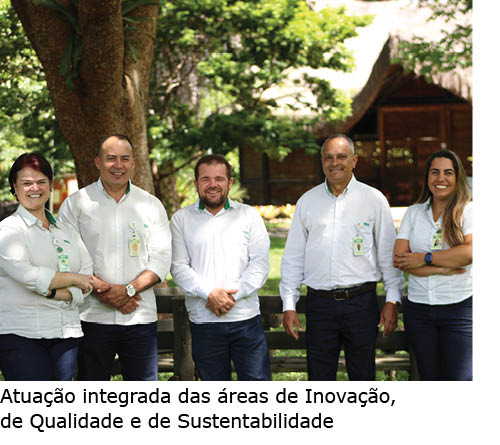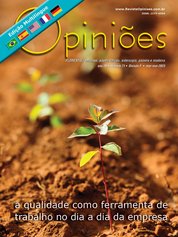Sergio Lopes dos Santos
Coordenador de Inovação e Qualidade Florestal da Veracel
OpCP71
Programa Mata Atlântica
A restauração ecológica passou a ser considerada, ao longo do tempo, uma estratégia para a manutenção da biodiversidade e da integridade de ecossistemas, gerando bens e serviços ecossistêmicos. Para que se possam restituir ecossistemas que sofreram distúrbios em grandes escalas e intensidades (não retornando ao estado de equilíbrio dinâmico), há necessidade de realização de projetos de restauração ecológica. A importância desses projetos é indiscutível para o reestabelecimento dos processos ecológicos e para a formação de florestas funcionais e sustentáveis.
Buscamos, aqui, de uma forma simples e objetiva, compartilhar reflexões, informações e práticas que, de alguma forma, possam contribuir para todas as pessoas interessadas nas questões ambientais e sua preservação.
O sucesso de qualquer empreendimento de restauração envolvendo plantios florestais depende de inúmeros fatores, como a escolha das espécies a serem utilizadas; as condições climáticase de solos apropriados; os conhecimentos sobre ecologia; os métodos de restauração; a qualidade das mudas, do preparo e da fertilização do solo; o plantio e os tratos culturais; a prevenção e o controle de pragas, doenças e matocompetição; a diversidade de espécies; a interação entre plantas e animais; as características ecológicas e fisiológicas das espécies; a tolerância à sombra; o entendimento sobre a dinâmica das florestas tropicais, dentre outros fatores.
A compreensão da funcionalidade dos ecossistemas naturais passa pelo desenvolvimento de tecnologias adequadas a diferentes contextos ambientais, econômicos e socioculturais, até a elaboração de indicadores de sustentabilidade capazes de facilitar o acompanhamento e a avaliação da eficácia da intervenção realizada.
Com a perspectiva de buscar melhorias no processo de restauração ecológica do já consagrado Programa Mata Atlântica, da Veracel, as áreas de Pesquisa e Desenvolvimento florestal, Qualidade e Sustentabilidade buscaram, em conjunto, avaliar a aplicação dos indicadores de manejo do eucalipto nas operações de restauração ecológica, sobretudo nos monitoramentos e na gestão da qualidade das operações.
No nosso ponto de vista, existem bons indicadores de produto (índice de sobrevivência, índice de diversidade, índice de crescimento etc.) para medir a eficácia dos programas de restauração. No entanto, ainda há uma grande margem para a evolução na gestão dos processos na restauração ecológica, sobretudo na estruturação de indicadores operacionais e de qualidade, na adoção de novas práticas de manejo, novos insumos sustentáveis e ecologicamente recomendados, dentre outras oportunidades.
Na fase de planejamento da restauração, a caracterização da vegetação da área é favorecida pelo uso de tecnologias como o LiDAR (Light Detection and Rancing), imagens de satélite, geotecnologias e drones, que são complementadas pelas avaliações de campo, considerando também proximidade com fragmentos florestais, aspectos edafoclimáticos e período ideal de plantio. Dessa forma, a metodologia mais adequada para o local é estabelecida levando em consideração as características do ambiente no momento histórico de uso e ocupação do solo e aspectos ambientais ao redor da área a ser restaurada.
A avaliação da qualidade das mudas é um fator importante e deve considerar aspectos como formação radicular, rusticidade, altura, aspectos fitossanitários, tamanho, substrato, dentre outros requisitos. Nas fases de preparo de solo (manual ou mecanizado), são monitorados espaçamento entre covas, faixas, núcleos e profundidade da cova.
No plantio, são avaliados a centralização da muda na cova, os danos mecânicos às mudas, o afogamento de coleto, a dosagem e a aplicação do gel de plantio e os cuidados gerais, como exposição de substrato. Nas operações de adubação, deve se atentar à aferição da dosagem recomendada e à adequada localização na aplicação do fertilizante.
 No controle de matocompetição, pragas e doenças, o suporte contínuo da área de Pesquisa e Desenvolvimento é imprescindível, sobretudo para a recomendação técnica de soluções de baixo impacto ambiental. As avaliações de sobrevivência podem ser favorecidas com o uso de drones. Tão importante quanto estruturar bons indicadores para a gestão da qualidade das operações, é definir rituais de gestão para análise crítica constante dos resultados, preferencialmente com a participação de equipe multidisciplinar (Sustentabilidade, Operações, Pesquisa e Desenvolvimento), de modo a garantir que as oportunidades de melhoria identificadas sejam rapidamente tratadas.
No controle de matocompetição, pragas e doenças, o suporte contínuo da área de Pesquisa e Desenvolvimento é imprescindível, sobretudo para a recomendação técnica de soluções de baixo impacto ambiental. As avaliações de sobrevivência podem ser favorecidas com o uso de drones. Tão importante quanto estruturar bons indicadores para a gestão da qualidade das operações, é definir rituais de gestão para análise crítica constante dos resultados, preferencialmente com a participação de equipe multidisciplinar (Sustentabilidade, Operações, Pesquisa e Desenvolvimento), de modo a garantir que as oportunidades de melhoria identificadas sejam rapidamente tratadas.
Para que haja o efetivo processo de restituição do ecossistema degradado a uma condição que crie meios de restabelecer a conectividade local e da paisagem, é necessário considerar também a importância da qualificação e o constante aperfeiçoamento técnico das equipes operacionais, além da busca incansável por soluções que sejam mais avançadas em termos de saúde, segurança e ergonomia para as equipes de campo. As coletas das informações nos monitoramentos de qualidade são realizadas com o uso de coletores de dados, e o controle estatístico do processo é estruturado em relatórios em Power BI.
A nossa experiência tem demonstrado que existem inúmeras oportunidades de transferir o conhecimento e a expertise obtidos com o já consagrado manejo de eucalipto para o manejo das espécies nativas nos programas de restauração ecológica, por meio do aprimoramento dos procedimentos e de instruções técnicas operacionais, da definição de indicadores críticos de sucesso, da análise crítica dos resultados e a sua frequente revisão, atualização e melhoria (processo dinâmico).
Além disso, foi possível observar que há oportunidades na utilização das novas e consagradas tecnologias adotadas no manejo do eucalipto para as operações de manejo e restauração ecológica. Como exemplo, a adoção de drones em operações especializadas, a utilização de sistema de gestão de frotas para o devido acompanhamento e controle das máquinas e equipamentos (acompanhamento em tempo real, telemetria, localização, produtividade, eficiência operacional e disponibilidade mecânica), dentre outras.
O aperfeiçoamento do manejo da restauração ecológica passa, sobretudo, pelo estabelecimento de parcerias com universidades, centros de pesquisa e ecossistemas de inovação, grupos de trabalhos em parceria com instituições públicas e privadas e pela atuação integrada das áreas de Sustentabilidade, Operações, Planejamento, Pesquisa e Desenvolvimento, na busca por novas soluções e tecnologias.
Do ponto de vista de novas perspectivas, a verdadeira jornada da descoberta não consiste apenas em avançar por novas fronteiras, mas, sobretudo, em ver com novos olhares as oportunidades na gestão da qualidade das operações nos processos na restauração ecológica.




